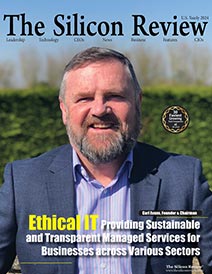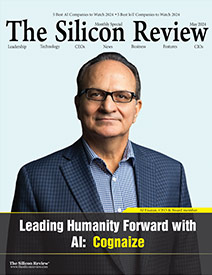50 Best Companies to Watch 2021
Justin Kromelow, Founder and CEO of OPOS, Speaks to The Silicon Review: ‘We Ensure Quality of Life by Transforming the Legitimate Use of Opioids into a Safer and More Effective Therapy’
The Silicon Review
![]()
“OPOS Foresight® uses OPOS proprietary risk stratification model to risk rate the prescribers’ opioid patient population as a means to improve patient safety. It creates a new revenue stream for the practice.”
Opioids have been regarded for millennia among the most effective drugs for the treatment of pain. Their use in managing acute severe pain and chronic pain related to advanced medical illness is considered the standard of care in most of the world. In contrast, non-prescribed opioids can be dangerous as such class of drugs can be highly addictive, and overdoses and death are common.
With that said, the consequences of opioid misuse can be devastating, exacting a heavy toll on patients, physicians, and society. Therefore, there is a need for therapeutic approaches that balance treating chronic pain while minimizing risks for opioid abuse, misuse, and diversion.
OPOS is one such company that is empowering safer and more effective opioid care. It provides a comprehensive range of products and services to enable physicians and organizations to safely and effectively manage populations receiving chronic opioid therapy. The company ensures that patients on long-term opioid therapy are closely monitored in a manner that maximizes their quality of life.
OPOS is based in San Mateo, California.
Interview Excerpt: Justin Kromelow
Brief us about the history of your company.
OPOS was founded in 2018 by the leadership team of the nation's largest chronic pain treatment company. For almost two decades, the team pioneered the use of telemedicine and treatment options that enabled patients to be productive and independent. The team experienced hundreds of primary care referrers overwhelmed by the regulatory compliance and patient safety complexities of the controlled substance medications commonly used for pain management. OPOS recognized an opportunity to bring additional tools and pain specialty support directly to the primary care practice, where most opioids are prescribed for chronic pain. Using a combination of expertise and technology developed over decades of treating thousands of chronic pain patients, the company was launched to deliver a new treatment and monitoring paradigm to the chronic pain community.
Q. OPOS was founded by experienced healthcare providers, data scientists, IT experts, and seasoned business professionals, as you mentioned. How did this idea come to your mind? Was there any prior experience that led to the establishment of the company?
In response to the opioid epidemic, as early as 2014, we began to observe a media message and public policy response to physician-prescribed opioids as the culprit of the opioid epidemic. Today, while it is widely recognized that in fact was not the case, the response created the complex prescribing environment we face today. Physician practices are overwhelmed with new time-consuming and complex regulatory compliance measures, barriers from insurance companies, and onerous information requests and delays from pharmacies. These factors increase physician practice costs to an unmanageable level. Some providers stopped prescribing opioids, who continue to face the increasing risk of state medical board scrutiny, could jeopardize their medical license. Besides, the threat of a medical board action further decreases the availability of opioid treatment providers. As we observed these problems and recognizing the large population of patients reliant on long term opioid therapy for quality of life, we formulated a solution to better align physicians and patients. Our experience told us that the right combination of technology, data science combined with our expertise and experience could solve the complex compliance and risk challenges.
Q. Your company transforms the legitimate use of opioids into a safer and more effective therapy without abandoning patients that demonstrate long-term benefit. How do you interpret this further?
The reduction of access to providers willing and capable of prescribing opioids is the net result of the opioid epidemic, insurance company and regulatory market forces. Public policy and healthcare reforms primarily targeted the two million adults that suffer from addiction and abuse problems related to opioids. Unfortunately this has a large impact on reducing or eliminating access for the 15 to 30 million adults that have relied on long-term opioid therapy and have already demonstrated years to decades of safe use and positive functional benefits to enable quality of life and independence. Keep in mind, for many of these patients, there are no alternative therapies or procedures that are effective.
By managing prescribers risk through ensuring regulatory compliance and providing patients with the ability to demonstrate functional gain, we have reduced the barriers for physician prescribing and improved the dialogue between physicians and their patients based on data and patients daily experiences.
By transforming the physician-patient relationship from a brief sporadic interchange, typically based around brick and mortar, to an ongoing dynamic exchange, based on objective and subjective data, physician resources can be applied wherever appropriate rather than being dictated by scheduling limitations of the healthcare enterprise.
Q. OPOS provides opioid prescribers with a complete picture of a patient's benefits and risks, reducing the burden and liability while increasing regulatory compliance. How uniquely do you address your patients' pain points in accordance with this?
We have all been asked the question, “On a scale of 1 to 10, what number is your pain?” This approach is the basis of the pain alleviation model used throughout healthcare. For chronic pain patients, it is doomed to fail because pain will never be completely eliminated without a significant risk of overmedication and impairment. OPOS eclipsed the pain alleviation model and with a functional view of the world based on a patient's personal goals. We ask, “What is important to you to do or accomplish?” The functional approach provides a specific goal, like walking my child to school, working a full-time job, volunteering in my community, or living independently. We can manage pain to enable function for a patient to be successful and have a quality of life that is consistent with their personal goals. There will always be some pain but that is overshadowed by a sense of accomplishment and fulfillment which is the key to quality of life.
Delineate a short overview of the services OPOS offers.
OPOS Foresight®: A Mobile Application that provides patient education, captures the patients' pain experience, functional abilities and supports communication and telemedicine encounters. All of the data is communicated to the patient's primary prescriber. For the prescriber, OPOS Foresight® documents regulatory compliance, including state prescription monitoring programs, functional assessment, and polypharmacy analysis. OPOS Foresight® uses the OPOS proprietary risk stratification model to risk rate the prescribers' opioid patient population to improve patient safety. OPOS Foresight® creates a new revenue stream for the practice.
OPOS telepain.MD: A pain specialist service provider utilizing OPOS Foresight® and placing a board-certified pain specialist in a primary care practice, as part of the group, to manage its chronic pain patients, including creating chronic pain treatment plans and managing all pain medications. This service delivers practice expertise and risk reduction while increasing practice revenue and profitability.
Q. Keeping in view what your company is offering, the future seems highly promising. Just out of curiosity, where do you see your company a couple of years from now?
In the future, we believe that all pain medication will be prescribed with a digital therapeutic like OPOS Foresight®. Rather than the patient narrative being limited to short scheduled encounters, the on-going monitoring and dialog between the patient and physician will support real-time feedback that will keep patients safer, produce better outcomes, and enable the physician to spend their time with the patients that need it, when they need it.
The Visionary Leader at the Helm of OPOS
Justin Kromelow, Founder, serves as the Chief Executive Officer of OPOS. Before founding OPOS, he served as CEO of Health Education for Living with Pain (HELP), the largest chronic pain provider network in California, and a pioneer in the development of telemedicine. During his 10 years at HELP, he transformed direct patient care into a functionally based telemedicine model, enabling rural areas to have access to specialist care. Prior to HELP, he founded several companies over two decades providing thought leadership, executive consulting, systems development, and integration services spanning Healthcare and Life Sciences. A principal interest throughout his career has been the application of technology to transform healthcare.









